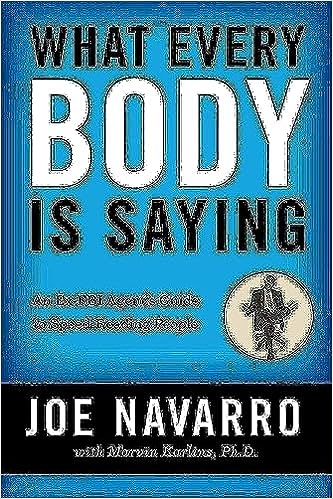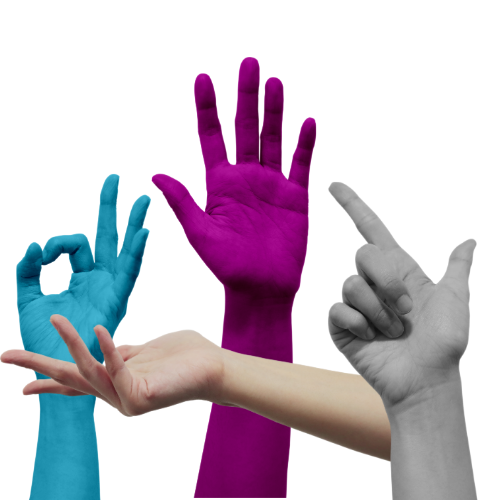Saying...Determine how to read the signals offered by your body language. What Every BODY is Saying (2008), published by a former FBI agent, might be your pocket handbook to nonverbal information.
Learn how to decipher the hidden secrets that everyone communicates by reading about the hidden power of body language and how to do it here.

Table of Contents
Overview
Joe Navarro is a former Federal Bureau of Investigation (FBI) agent who now works as a criminal investigation consultant. Based on his experiences in both of these professions, he gives a guide to reading body language in his book, What Every Body Is Saying.
Because body language is harder to lie with, it can reveal feelings that were previously hidden and show when someone is lying.
Even people who aren’t experts can learn to notice and understand the many signals that are sent through body language. This will help them communicate better.
When someone is dishonest, their body language may reveal concealed happy thoughts or hidden negative feelings that do not match the content of the words they are saying.
How the limbic system responds to stress is the most telling part of body language. It starts with the freeze response, which can be seen when someone gestures while talking and then quickly stops, showing surprise.
This indicates that the individual has been surprised. This limbic system response progresses to a flight-or-fight response, which can result in flushing, flared nostrils, and dilated pupils, among other physical signs.
Feelings are expressed in very similar ways through the legs, chest, arms, and hands. While symmetrical behavior indicates confidence in the integrity of the allegations being made, asymmetrical behavior may indicate a lack of confidence in the individual in question.
Sagging shoulders, frowning, wincing, guarding, and blocking are markers of disgust, tension, and sadness, but upward motion in the hands and feet is suggestive of delight.
Look for transitions from comfortable to uncomfortable situations, as well as vice versa. This is the most advanced lie-detecting technology currently available.
However, detecting a lie is extremely difficult, and indicators from a person’s body language are not necessarily a trustworthy forecast of their intentions. This suggests that the context is still highly important.
SUMMARY OF “WHAT EVERYBODY IS SAYING”
Introduction
Have you ever seen the meme that goes around on Facebook that says, “I’m sorry for what my face said while you were talking?” This meme makes us giggle because we can all relate to it.
Even if we are successful in concealing our genuine feelings, our expressions often expose them. As an example, our words may convey the impression, “Oh, you’re not unpleasant at all!” but we are privately wondering if this individual will ever be silent.
And this annoyance can be evident in our features even though the words coming out of our mouths say something completely different.
In certain cases, we may wish that the person with whom we are communicating is unable to decipher the meaning of the body language we are attempting to conceal from them.
On the other hand, being able to interpret subtle nonverbal clues can be a very useful skill in a variety of other circumstances. For example, suppose you want to learn how to tell if someone is telling the truth to you.
In situations like this, having skills like these can be really useful! This book, however, is about much more than only detecting falsehoods; it is also an authoritative guide to understanding the various types of nonverbal human behavior.
As a result, throughout this description, we will delve into the immense repository of nonverbal knowledge cultivated by a former FBI agent and learn how you can utilize his greatest advice in your own life.
As Detailed in Chapter 1
NONVERBAL COMMUNICATION IS MORE HONEST THAN OUR WORDS

People are always caught lying. Whether we like it or not, lying is a necessary part of the human experience, just like breathing and eating.
However, we do not always lie with the goal of causing harm; there are times when we just utter a lie to spare another person’s feelings.
Is it really important, for example, if your friend knows you secretly detest the clothing she’s wearing? Is it important for you to inform your mother-in-law that you dislike the potato salad she makes?
When it comes to little details, speaking the truth might have far more negative effects than favorable ones, which is why we occasionally lie. But what about the bigger lies?
Which are the most significant lies? That mess with other people’s brains and lives? It is occasionally critical to be able to identify when someone is lying to you, especially when dealing with more subtle and covert lies. And in instances like these, the ability to interpret nonverbal cues can be highly useful.
The author’s time working for the FBI taught him that, no matter how dishonest our words are, our bodies always tell the truth.
In fact, our bodies are so honest that they can reveal us even when we are attempting to tell a lie, and this can happen even when we are not being consciously dishonest.
For example, you may have heard the adage “the eyes are the window to the soul.” This is frequently true because, when someone is lying, their eyes can betray them in a variety of ways.
For instance, you may have heard the phrase “the eyes are the window to the soul.” Some people may instinctively try to avoid your gaze while fooling you.
When someone is worried about their lie, they may blink quickly five or six times in a row, and their eyes may dart around the room like a cornered animal.
You can determine if someone is lying by following the direction their eyes are looking. Consider the following scenario: You question someone about something they witnessed.
If she saw what she claims she saw, her eyes will most likely go up and to the left, indicating that she is accessing her visual memory and attempting to recall the specifics of what she saw with her own eyes.
If she saw what she claims to have seen, her eyes would most likely move in this fashion. If, on the other hand, her eyes travel upward and to the right, she is attempting to invent details with her imagination.
These nonverbal indicators may be readily ignored if the observer is not paying attention due to their simplicity. However, if you know what to look for, you may discover that people’s bodies communicate the truth even when their words do not.
This is something you can only find if you know what to look for.
When trying to talk to someone with neurodiversity, mental illness, or a physical disability, it’s important to pay attention to their nonverbal cues.
When conducting an interview with a person that fits into one of these categories, it is critical to keep the differences between the two in mind. If you’re working with a normal, neurotypical person, you can use these behavioral cues to detect when they’re lying.
Chapter 2
THE REALITY OF OUR BRAINS

We established in the last chapter that our body language can communicate the truth even when our words cannot. But where does this forthrightness about one’s physiological status come from?
And how are we to make sense of the massive gaps in our spoken and nonverbal means of communication? If you’re unfamiliar with the limbic brain, let’s spend some time learning about it.
According to the author, this distinction stems from our limbic brain, often known as our “honest brain.” The limbic system, a part of the brain that controls our behavioral and emotional reactions, is in charge of these.
It aids in the regulation of many of the instincts that are required for human survival. The limbic system, for example, is in charge of regulating our “fight or flight” response, as well as our reproductive instincts and hunger.
The limbic system never sleeps since it is in charge of our body’s innate defense mechanisms, and it never stops trying to protect our survival.
Our limbic system is so basic that it reacts even when we are not consciously thinking about something. Because of this, it is hard to trick or control our limbic systems in an unethical way.
All you have to do to acquire a better understanding of how it works is consider how lying works. Assume your mother asks you for your opinion on whether her turkey is too dry on Thanksgiving.
The turkey has been roasted for far too long to be appetizing; it is as dry as a bone and has a dreadful flavor. You are aware, though, that your mother worked very hard to prepare the turkey, and you do not want to make her feel guilty.
As a result, whether or not you are aware of it, your brain is constantly executing a variety of mental computations in the background.
What is your mind attempting to communicate to you?” Okay, after some consideration, we’ve concluded that informing her that the turkey is overcooked would be inappropriate.
“No, I think the turkey tastes great!” we’ll remark in response. As a result, as your brain performs those calculations swiftly, it is simultaneously delivering information to your tongue and improving your linguistic abilities.
And it’s too late by the time you’re ready to say, “No, the turkey tastes great to me!” Even though you are aware that what you are about to say is false, your tongue and brain are fully prepared to say it.
It will, however, take some time for your body to catch up. Regardless of how well prepared our minds and tongues are, lying is extremely difficult for our bodies.
As a result, whether you are conscious of it or not, lying raises your heart rate, causes you to sweat, and causes your mouth to dry out.
As a result of your anxiety, you may find yourself becoming shaky and having difficulty breathing. The stimulation of your limbic system, which is the portion of your brain that drives your “fight or flight” response, is the core because of your anxiety symptoms.
As a result, even if you are cognitively and emotionally prepared to lie, your limbic system is aware that lying can ruin your reputation as well as your relationships with others, and your body will experience stress as a result of this information.
As a result, your body may be able to tell when you are lying by the way it reacts. Even if you can keep your cool and are well prepared to tell a lie, your physical body may be in a state of panic, manifesting as trembling, sweating, and stiff conduct, all of which are nonverbal indications that someone else is picking up on.
Chapter 3
DEALS WITH HONEST HANDS AND HONEST FEET, WHICH DEALS WITH THE HONEST HANDS AND HONEST FEET CONCEPT
Are you familiar with the adage, “See no evil, hear no evil, and speak no evil”? Because it is so common in modern culture, most of us have probably forgotten where it came from and what it was supposed to mean.
People in the West often use the phrase “turning a blind eye to wrongdoing” to criticize those who don’t care about or downplay the wrongdoing of others.
However, this idiom was derived from a Buddhist proverb that served an important purpose. This phrase was intended to serve as a mild reminder to avoid dwelling on negative or disturbing thoughts.
The eyes, the ears, and the mouth are the three primary body parts most commonly associated with knowledge and communication. The proverb advised us not to fill our minds with evil by addressing the eyes, ears, and mouths, which are three of the most important parts of our bodies.
Given that we see with our eyes, hear with our ears, and speak with our lips, it makes perfect logic to refer to these particular body parts.
Because we use these parts of our bodies so often, it’s easy to think that they are the most important parts when it comes to sending and receiving messages.
But the author’s education has taught him that there are other parts of the body that can communicate and be honest even better.
And this honesty comes from two body parts that we presumably wouldn’t associate with communication: our hands and feet. Therefore, are our hands and feet acceptable deception tools?
Or, alternatively, to tell the complete truth? The author’s personal experience has taught him that we are able to. In the previous chapter, we learned how the limbic system sends distress signals to our bodies when there is a disconnect between what we know and what we say. This chapter will continue our examination of the limbic system.
But now is the time to look at how the limbic system affects our body language in more depth. When the body senses a possible threat, the limbic system turns on the “fight or flight” response, which causes a lot of adrenaline to be released.
So, let’s say, for the sake of illustration, that you are currently lying. You possess composure and are preparing to execute your deception as intended.
Perhaps you have even been able to conceal the additional tense nonverbal cues associated with deception. If so, congratulations!
Conversely, it appears that you have no control over your limbs and feet. Due to the adrenaline that is presently coursing through your body, your hands and feet may begin to tremble.
In addition, you may begin to touch or move your feet. Therefore, if your hands begin to tremble and your feet begin to tap up and down reflexively, you are definitely lying.
This is something that can be decoded by anyone who is familiar with reading body language, depending on their level of familiarity.
The most essential thing I’ve learned from this chapter is that our hands and feet will always give us away, no matter how hard we try to hide something.
Chapter 4
THE ART OF READING BODY LANGUAGE
In the chapter preceding this one, we examined some of the most prevalent forms of nonverbal communication. We have also gained an understanding of the relationship between our bodies and minds, as well as the ways in which this relationship can influence our behavior when we are dishonest.
This chapter will expand on the information presented in the previous chapter by providing a more in-depth examination of the study of body language and a review of some common techniques for deciphering what everyone is saying.
When it comes to the study of body language, the author emphasizes the importance of developing keen observational skills and a thorough understanding of the individual whose body language you are endeavoring to interpret.
Obviously, if you are an FBI agent conducting an interview with a suspect for the first time, this can be somewhat difficult. However, the average person is not an FBI agent, and it is extremely unlikely that you will interrogate a suspect professionally in the near future.
Instead, you are presumably concentrating on someone you already know well, such as your spouse or a child.
If this is the case, it is crucial to gain a thorough understanding of the individual’s typical nonverbal communication styles. In any case, you won’t be able to recognize that something is amiss if you don’t know what “normal” is! Start by ensuring that you have a firm understanding of the individual in question and their typical behavior.
Developing your ability to make observations is the next step you should take if you are confident that you have acquired the necessary knowledge.
When you have strong observational abilities, you will be able to maintain track of multiple details at once. When you enter your kitchen, for instance, you may notice dishes in the sink, an open dishwasher, butter left on the counter, and empty plates scattered across the breakfast table.
All of these items may simultaneously come to your attention.
As this example demonstrates, having strong observational skills enables you to monitor your surroundings and glean a significant quantity of information from a few well-placed glances.
Examining a person’s nonverbal behavior provides the same insights as examining their verbal behavior. For instance, if you have a strong relationship with your son and know him very well, you may be able to immediately identify any unusual behavior.
It’s possible that you’ll notice that he’s bouncing his leg while he’s speaking to you; you’ll recognize this as an unusual behavior on his part because it’s not something he normally does.
Given that he typically maintains eye contact, it’s possible that you’ll notice that he’s looking away from you while he’s speaking to you, which will strike you as strange.
If you have honed your observational skills, you will be able to combine these signs into a coherent behavioral analysis and confirm that something is amiss: your son is concealing something from you.
This is merely a hypothetical example, but as you can see, it is not difficult to develop excellent observational skills that can help you interpret the behavior of others. These abilities are quite essential.
Chapter 5
CONCLUSION AND RECOMMENDATIONS
Due to television programs such as Law & Order: Special Victims Unit and Criminal Minds, the function of the behavioral analyst has taken on an aura of mystique.
We are captivated by their abilities and believe they possess some form of extraordinary talent, as they demonstrate an almost superhuman ability to enter the minds of their suspects.
In reality, however, behavioral analysts are merely individuals who have honed their observational skills and have a thorough understanding of nonverbal communication. In actuality, anyone is capable of developing these skills if they follow the advice presented in this book.
KEY TAKEAWAYS
- Nonverbal communication is defined as the expression of inner sentiments through gestures that are more difficult to control or conceal than words. As a result, it is a more accurate method for determining a person’s genuine feelings about the topic under discussion.
- The limbic region of the brain is responsible for controlling emotional and instinctual responses to stimuli. This portion of the brain is also responsible for triggering certain revealing body language cues. The limbic system is the portion of the brain responsible for observable stress responses.
- People may be able to determine if they are experiencing the freeze response by the abrupt cessation or restraint of their gestures. It indicates that a stimulus caused the individual to experience either surprise or tension.
- The flight-or-fight response is responsible for the physiological changes that indicate heightened tension, such as sweaty hands, flared nostrils, flushed face, and dilated pupils.
- When faced with a distressing situation, a person may engage in calming behaviors, such as stroking their legs or rubbing their neck, in an effort to reduce the physiological effects of the stress response.
- Taking delight in viewing something typically results in behavior that enhances one’s ability to take pleasure in viewing it. People have a tendency to avert their gaze or cover up distressing objects in order to avoid seeing them.
- Positive emotions, such as happiness or elation, can motivate individuals to move their hands or feet from their normal resting positions. Negative emotions can lead to behaviors that make the body appear smaller than it actually is, as well as muscles that are constricted.
- When people feel uneasy in social situations, they defend themselves by leaning away from the other person, partially confronting them, and placing a knee or their arms between them.
- If two individuals are having a positive exchange, they may begin to mimic one another’s mannerisms and poses.
- Feet and legs are frequently the body parts that reveal the most about a person, as they can communicate a wide range of emotions and their activities are difficult to conceal.
- The most effective method for detecting deception is to observe variations in a person’s posture, specifically transitions between comfortable and uncomfortable postures. To make an appropriate evaluation, the viewer must have a foundational understanding of how people behave when not under duress.
- Practically every action may be the consequence of multiple factors. Keep an eye out for sudden behavioral changes that can be attributed to a specific stimulus, as well as clusters of gestures that all point to the same thing.

”Widen The Window”(2019) Book Summary
Window ...A pioneering researcher provides us with a fresh understanding of stress and trauma in addition to the means to recover and thrive.

Buy this book @ Amazon:”What Every BODY is Saying” An Ex-FBI Agent’s Guide to Speed-Reading People Paperback – April 15, 2008
Buy this book @ Amazon: ”What To Eat When”: A Strategic Plan to Improve Your Health and Life Through Food
Read more book summaries: “If a human has no direction, every wind is a fresh breeze” ― lenfantvivant
“Thought is only an abstraction representing a fraction of what is.” ― Lenfantvivant
”Widen The Window”(2019) Book Summary
Summary of “Atomic Habits” (2018)
”Yes, And” Book Summary (2015)
Summary of:”No Matter Where You Go, There You Are ”By J. L. Mallory (2016)
Summary of “Atomic Habits” (2018)
“When You Die, Who Will Cry?” Book Summary For Robin Sharma (1999)
https://www.amazon.com.tr/Way-Zen-Alan-W-Watts/dp/0375705104
quotes in our website: https://psytify.com/quotes/
More quote resources: https://en.wikiquote.org/wiki/Main_Page
quotes in our website: https://psytify.com/quotes/
More quote resources: https://en.wikiquote.org/wiki/Main_Page


